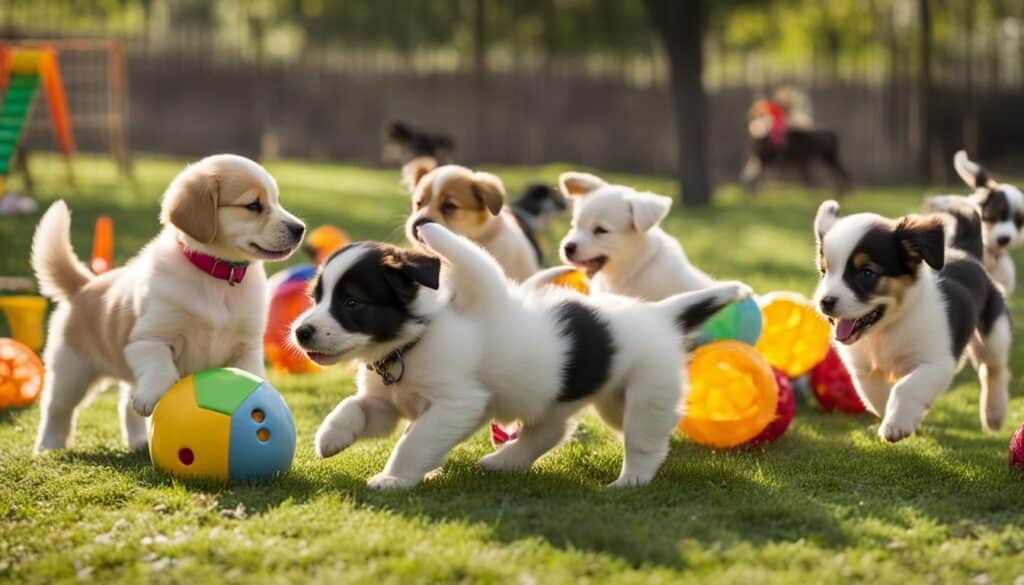Positive reinforcement dog training is a scientifically proven and effective method of training dogs. Unlike traditional training methods that rely on punishment or dominance, positive reinforcement focuses on rewarding desired behaviors to encourage their repetition.
The science behind positive reinforcement is rooted in the concept of operant conditioning. Dogs learn through consequences and rewards; positive reinforcement utilizes this principle to shape their behavior. By associating desired behaviors with positive rewards such as treats, praise, or playtime, dogs are motivated to repeat those behaviors.

Key Takeaways:
- Positive reinforcement dog training is a scientifically proven and effective method.
- It is based on the principle of using rewards to encourage desired behaviors.
- The science behind positive reinforcement involves operant conditioning and shaping behavior through consequences and rewards.
- Positive reinforcement creates positive associations and increases motivation for dogs.
- Understanding the science behind positive reinforcement is crucial for successful training outcomes.
Why Positive Reinforcement in Dog Training is Effective
Positive reinforcement is a scientifically proven and highly effective method of training dogs. Understanding the science behind positive reinforcement is critical to implementing it correctly and achieving successful training outcomes. We can highlight its benefits and advantages by comparing positive reinforcement to other training methods. Positive reinforcement supports desired behavior in dogs and strengthens the bond between the dog and their owner.
Understanding the Science Behind Positive Reinforcement
Positive reinforcement in dog training is based on the principles of operant conditioning. This scientific approach focuses on shaping behavior through consequences and rewards. Using positive reinforcement, we create positive associations in dogs’ minds, motivating them to repeat desired behaviors. It increases their motivation to learn and perform well.
Comparing Positive Reinforcement to Other Training Methods
Positive reinforcement is a superior approach compared to other training methods, such as punishment-based techniques. Punishment-based methods may suppress unwanted behaviors, but they can also lead to fear, anxiety, and aggression in dogs. In contrast, positive reinforcement creates a positive and enjoyable learning environment where dogs are motivated to engage and connect with their trainers.
How Positive Reinforcement Supports Desired Behavior in Dogs
Positive reinforcement supports desired behavior in dogs by providing rewards for good behavior. Whether it’s treats, praise, or playtime, these rewards create positive associations with the desired behaviors, making dogs more likely to repeat them. It helps dogs understand desired behaviors and encourages them to continue behaving appropriately. Positive reinforcement is a powerful tool for promoting and reinforcing desired behavior in dogs.
The Role of Operant Conditioning in Positive Reinforcement Training
Operant conditioning is a fundamental principle in positive reinforcement training for dogs. It forms the basis of this highly effective training method, allowing trainers to shape and reinforce desired behaviors.
The Four Quadrants of Operant Conditioning Explained
Operant conditioning is divided into four quadrants, each representing a different type of consequence that can influence behavior:
| Quadrant | Consequence Type |
| Positive Reinforcement | Rewarding desired behavior to encourage its repetition |
| Negative Reinforcement | Removing or avoiding an aversive stimulus to reinforce desired behavior |
| Positive Punishment | Applying an aversive stimulus to discourage undesired behavior |
| Negative Punishment | Removing a desirable stimulus to discourage undesired behavior |
In positive reinforcement training, trainers primarily focus on using positive reinforcement, where desired behaviors are rewarded with treats, praise, or toys. This reinforcement serves as an incentive for dogs to repeat those behaviors, leading to their increased occurrence over time.
Practical Examples of Operant Conditioning with Dogs
There are various practical examples of operant conditioning in positive reinforcement training for dogs:
- Using treats as rewards for following commands or exhibiting desired behaviors
- Offering praise and petting when dogs display appropriate behavior
- Using toys or playtime as rewards for learning new tricks or skills
These examples demonstrate how operant conditioning techniques can effectively shape and reinforce behaviors, promoting positive and desirable outcomes in dog training.

How to Implement Positive Reinforcement Dog Training Correctly
Implementing positive reinforcement dog training correctly is crucial for achieving successful training outcomes. This section will discuss critical factors, including choosing the right rewards, timing, consistency, and avoiding common mistakes in positive reinforcement.
Choosing the Right Rewards for Effective Training
When implementing positive reinforcement training, choosing the right rewards for your dog is essential. Different dogs may have different preferences, so it’s important to find what motivates and excites them. Rewards can include treats, praise, toys, or any positive stimuli your dog finds rewarding. You can increase their motivation to engage in desired behaviors by using rewards that your dog values.
Timing and Consistency: Keys to Success in Positive Training
Timing and consistency play a crucial role in positive reinforcement training. Rewards should be given immediately after the desired behavior occurs to effectively reinforce it. This creates a clear association between the behavior and the reward, helping your dog understand what they did right. Additionally, consistency in training is vital. Regular and consistent training sessions help reinforce the desired behavior and prevent confusion or inconsistency. Establishing a routine will teach your dog to associate specific behaviors with positive rewards.
Trainer Tips: Avoiding Common Mistakes in Positive Reinforcement
To ensure the success of positive reinforcement training, it’s essential to avoid common mistakes that can hinder progress. Here are some tips to help you avoid these pitfalls:
- Avoid using inconsistent rewards or punishments, which can confuse your dog and undermine training.
- Avoid punishing your dog for unwanted behaviors. Instead, focus on redirecting their attention to desired behaviors and rewarding them.
- Be patient and understanding. Positive reinforcement training takes time and effort, so avoid becoming frustrated or impatient with your dog’s progress.
- Stay consistent with your training methods and rewards. Changing the rules or rewards can confuse your dog and impede their progress.

| Common Mistakes to Avoid in Positive Reinforcement Training | Recommendations |
| Using inconsistent rewards or punishments | Stay consistent with rewards and avoid punishments |
| Punishing unwanted behaviors instead of redirecting | Focus on redirecting to desired behaviors and rewarding them |
| Becoming impatient or frustrated | Be patient and understanding throughout the training process |
| Inconsistent training methods and rewards | Stay consistent with your training methods and rewards |
Understanding the Impact of Negative Punishments and Reinforcements
Regarding dog training, it is crucial to understand the impact of negative punishments and reinforcements. Negative punishments involve the removal of a desired stimulus to decrease undesirable behavior, while negative reinforcements involve the removal of an aversive stimulus to increase desired behavior. The difference between the two lies in the presence or absence of an aversive stimulus.
Positive methods, such as positive reinforcement, are preferred over aversive techniques. Positive reinforcement rewards desired behaviors, increases motivation, and creates positive associations. This not only helps train dogs effectively but also enhances their overall well-being.
On the other hand, negative approaches can have adverse psychological effects on dog behavior. Dogs may experience anxiety, fear, or even aggression when subjected to aversive techniques. These adverse effects can hinder the training process and damage the dog’s and the owner’s bond.
Therefore, it is essential to prioritize positive methods and avoid aversive techniques in dog training. By utilizing positive reinforcement and focusing on the psychological well-being of dogs, trainers can achieve desired behaviors while maintaining a positive and trusting relationship with their furry companions.
Advanced Techniques and Concepts in Positive Reinforcement Training
Advanced techniques in positive reinforcement training build upon the foundation of science-based principles and explore new horizons in dog training. These techniques go beyond teaching basic commands and challenge dogs and trainers to reach new levels of understanding and success.
Integrating Science-Based Dog Training Principles
Integrating science-based principles into positive reinforcement training allows trainers to understand better how dogs learn and respond to stimuli. By staying abreast of the latest research and behavioral studies, trainers can refine their training methods and maximize the effectiveness of positive reinforcement.
Expanding Training Beyond Basic Commands: Dog Sports and Tasks
Positive reinforcement training doesn’t just stop at teaching sit, stay, and come. It opens up many possibilities, including engaging in dog sports and teaching specific tasks. From agility training to nose work, these activities stimulate the dog’s mind and body, creating a balanced and fulfilling training experience.
Training Difficult Dogs: Utilizing Positive Reinforcement in Challenging Situations
Training difficult dogs can be daunting, but positive reinforcement remains a valuable tool even in the most challenging situations. Whether dealing with fearful or reactive dogs, patience, consistency, and understanding are key. By using positive reinforcement techniques tailored to specific behaviors and individual needs, trainers can build trust and confidence in these dogs.
| Training Difficult Dogs | Positive Reinforcement Strategies |
| Fearful Dogs | Gradual desensitization, counter-conditioning, reward-based shaping |
| Reactive Dogs | Focus training, redirection, rewarding alternative behaviors |
| Aggressive Dogs | Behavior modification, controlled exposure, reinforcing calm behavior |
How Positive Reinforcement has Revolutionized Dog Training
Positive reinforcement has ushered in a new era of dog training, ultimately transforming how we interact with our furry friends. This humane, effective, and science-based approach has revolutionized the dog training industry, providing a kinder alternative to outdated methods that relied on punishment and aversive techniques.
Trainers and owners worldwide have experienced firsthand the incredible efficacy of positive reinforcement. Using rewards, such as treats, praise, and play, to reinforce desired behaviors motivates dogs to learn and cooperate willingly. This positive approach improves their behavior and strengthens the bond between the dog and their owner.
Testimonials from trainers and owners abound, highlighting the remarkable results achieved through positive reinforcement. From overcoming challenging behavioral issues to mastering complex commands, dogs thrive when trained using these methods. The success stories testify to the power of positive reinforcement in transforming dogs into well-behaved, happy, and confident companions.

